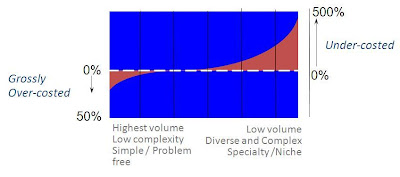Do you have good Hospital Management system?
Does the system have Cost centre accounting? Do
you use the functionality?
Does it have integrated Stores Management system?
Do you get the profitability information at the
Speciality unit level? (For Example: Paediatrics, Cardiology, Orthopaedics
etc.)
Possible scenario – Most of the major hospitals use
one or the Hospital Management System (an ERP for Hospitals). This includes the
expense management as well as used for billing the patient as per the services
utilized. Though this system has a facility to define various cost centres, the
users may not use the facility and cannot collect the expenses as per various
cost canters. If this cost centre accounting is not done, then
·
The basic and high level
profitability at the Speciality units (For Example: Paediatrics, Cardiology,
Orthopaedics etc.) is not available
·
The cost of general shared
services like HR, Admin etc. or operational shared service like Laundry,
Equipment maintenance are allocated like ‘peanut butter spread’
·
It is highly impossible to get
the Procedure level cost or patient level costs
·
The cost of items provided for
procedures like valves, stents etc. or consumables to various specialities
cannot be allocated
Do you know, how the services like HR,
Administration, IT, Laundry, Maintenance etc. are consumed by others?
Possible Scenario – As the Activity Based Costing
(ABC) methodology is not adopted by the Hospital it is not possible for them to
get information on this. The ABC methodology would provide them the information
on
·
What are the different services
provided by the shared service departments
·
What is the cost of each
service?
·
Can the non-core and high value
service be outsourced?
Do you know the cost of Procedures within each
speciality area?
Possible Scenario – The hospital may be calculating
those costs at a very high level by collecting in the information of the cost
that is directly attributable to the procedure like specialist fees, external
services hired, consumables etc. This may not the total cost of the procedure
as all other indirect cost are not known or cannot be allocated accurately.
The ABC methodology can calculate the cost of each
procedure based on the activities performed by the speciality department or any
other shared services. This would lead to accurate information of procedures
and find the profitability of the procedures. If there are multiple hospitals
in a group
then the cost of procedures can be compared across
various hospitals and the reasons for the differences can be identified. It can
also lead to the understanding of the ‘non-value added’ activities in the
procedures and can be eliminated to improve profitability.
Do you know the profitability by patient?
Possible scenarios - The hospital may know the
services provided to each patient and at the end, billing done by each service.
The hospital may not know the cost of each service and hence, what is the
profitability by each patient. The ABC methodology provides the cost of each
service loaded with the shared service cost which in turn provides accurate
information on patient level profitability. Though for hospitals the patient
may not repeat this information of patient level profitability can be used by groping
the patients by their demographic information available like age, disease,
procedures provided, life-stage, income group etc. This profiling would help
the hospital to find which patient segments are profitable across which
speciality areas and then try acquire them preferentially.
Do you know the utilization of various speciality
areas?
Can you plan your resource requirement for the
future?
Possible scenario – The hospital has to invest
heavily in the infrastructure to provide various special services to the
patients. Not all the service areas are utilized completely. The hospital may
know the capacity of the speciality area at a very high level and the
utilization also would be known at a gross level. ABC methodology can possibly
define the capacity of the infrastructure at a detail level. The same can help
the hospital to predict the resource requirement in future based on the
expected demand for various speciality areas.
Do you know the cost of acquiring a patient using
multiple channels?
Possible
scenario – The hospital may be using various channels to acquire the patients.
Those could be
a) Hospital OPD (Outpatient department)
b) Referrals
c) Direct (Generally called ‘walk-in’, but may not be
the same case hereJ)
·
Accident
·
Criminal
The cost of acquisition for those patients may not be
known to hospital, except for the direct services charged paid.
The ABC methodology can provide the cost of running
those channels as well as total cost for acquiring a patient using this
channel. Like cost of acquisition, there may be a possibility the cost of
closure (payment and discharge activities) different for the patients acquired.
The same can be identified and used for providing the direct or indirect
benefits to the channel partners.






